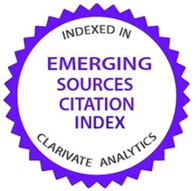Gestión de la capacidad de respuesta en cadenas de suministro y preparación en emergencias para la seguridad y protección en países desarrollados
DOI:
https://doi.org/10.21830/19006586.735Palabras clave:
gestión de cadena de suministro, países desarrollados, preparación de emergencias, red de sensibilidad, seguridad y protecciónResumen
Las cadenas de suministro pueden desempeñar un rol importante en la reducción de amenazas a la seguridad y protección de países desarrollados, como Suecia. Este articulo ofrece perspectivas acerca de la cadena de suministro y deriva del concepto de preparación para emergencias. Varios desafíos impiden que las redes de actores se beneficien plenamente de la coordinación. El estudio enfoca el impacto de las redes de la cadena de suministro como una estrategia general para el manejo de la seguridad. Tres enfoques difieren en su impacto en la capacidad de las redes de actores envueltos; (i) un enfoque de planificación estratégica general, (ii) un enfoque de sistema integrado para la respuesta general, (iii) un enfoque de coordinación para gestionar la estrategia general de capacidad en respuesta a la cadena de suministro.
Descargas
Referencias bibliográficas
Alexander, D. (2002). From civil defense to civil protection and back again. Disaster Prevention and Management, 11(3), 209-213. https://doi.org/10.1108/09653560210435803
Alexander, D. (2005). Towards the development of a standard in emergency planning. Disaster Prevention and Management, 14(2), 158-175. https://doi.org/10.1108/09653560510595164
Alexander, D. (2006). Globalization of disaster: trends, problems and dilemmas. Journal of International Affairs, 59(2), 1-22. Retrieved from https://www.jstor.org/stable/24358424
Altay, G. (2006). OR/MS research in disaster operations management. European Journal of Operational Research, 175(1), 475-493. https://doi.org/10.1016/j.ejor.2005.05.016
Altay, N., Prasad, S., and Sounderpandian, J. (2009). Strategic planning for disaster relief logistics: lessons from supply chain management. International Journal of Services Sciences, 2(2), 142-161. https://doi.org/10.1504/IJSSci.2009.024937
Axelsson, B., and Easton, G. (Eds) (1992). Industrial Networks: A New View of Reality. Milton park, England: Routledge.
Bhalla, A.S., and Lapeyre, F. (2016). Poverty and exclusion in a global world. New York, NY: Springer.
Barton, H. (2000). Sustainable communities: The potential eco-neighborhoods (pp. 3-18). London, England: Earthscan.
Beamon, B.M. (2004). Performance measure in humanitarian relief chains. Issues and challenges. 34th International Conference on Computers and Industrial Engineering, San Francisco, CA.
Beamon, B. M., and Balcik, B. (2008). Performance measurement in humanitarian relief chains. International Journal of Public Sector Management, 21(1), 4-25. https://doi.org/10.1108/09513550810846087
Beamon, B., and Kotleba, S. (2006). Inventory modelling for complex emergencies in humanitarian relief operations. International Journal of Logistics, 9(1), 1-18. https://doi.org/10.1080/13675560500453667
Boin, A., and McConnell, A. (2007). Preparing for critical infrastructure breakdowns: The limits of crisis management. Journal of contingencies and crisis management, 15(1), 50-59. https://doi.10.1111/j.1468- 5973.2007.00504.x
Bouvin, E., Delin, M., and Rosén, H. (2020, June 13). Så spräckte coronapandemin Sveriges krisberedskap. Dagens Nyheter, pp. 1–9. Retrieved from https://dn.se/nyheter/sverige/sa-sprackte-coronapandemin-sveriges-krisberedskap
Bryman, A. (2015). Social Research Methods. Oxford, England: Oxford University Press.
Carmeli, A., and Schaubroeck, J. (2008). Organisational crisis-preparedness: The importance of learning from failures. Long Range Planning, 41(2), 177-196. https://doi:10.1016/J.LRP.200801001
Catalan, M., and Kotzab, H. (2003). Assessing the responsiveness in the Danish mobile phone supply chain. International Journal of Physical Distribution and Logistics Management, 33(8), 668-685. https://doi.org/101108/09600030310502867
Cohen, J. (2007). State and Civil Society in Northern Europe. (pp. 37-66). New York, NY: Berghahn Books.
Cornall, R. (2005). New levels of government responsiveness for ‘all‐hazards’: the management of natural disasters and emergencies. Australian Journal of Public Administration, 64(2), 27-30. https://doi.org/101111/j.1467–8500 2005 00433.x
Creswell, J.W. (2011). Controversies in mixed methods research. In N.K. Denzin, and Y.S. Lincoln (Eds.). The Sage Handbook of Qualitative Research (pp. 269-284). Thousand Oaks, CA: SAGE.
Christensen, T., and Laegreid P. (2001). New Public Management: The effects of contractualism and devolution on political control. Public Management Review, 3(1), 73-94. https://doi.org/10.1080/14616670010009469
Day, J. M., Melnyk, S. A., Larson, P. D., Davis, E. W., and Whybark, D.C. (2012). Humanitarian and disaster relief supply chains: a matter of life and death. Journal of Supply Chain Management, 48(2), 21-36. https://doi.org/10.1111/j.1745-493X.2012.03267.x
Gattorna, J. (2015). Dynamic supply chains: How to design, build and manage people-centric value networks. Upper Saddle Road, NJ: FT Press.
Gattorna, J. (2006). Living supply chains: how to mobilize the enterprise around delivering what your customers want. London, England: Pearson Education.
Ghosh, A., Das, S., and Deshpande, A. (2014). Effect of responsiveness and process integration in supply chain coordination. IUP Journal of Supply Chain Management, 11(1), 7-17.
Gray, C.S. (2010). Strategic thoughts for defense planners. Survival, 52(3), 159-178. https://doi.org/10.1080/00396338.2010.494883
Gunasekaran, A., Lai, K. H., and Cheng, T. E. (2008). Responsive supply chain: A competitive strategy in a networked economy. Omega, 36(4), 549-564. https://doi.org/10.1016/j.omega.2006.12.002
Guba, E.G., and Lincoln, Y.S. (1994). Competing paradigms in qualitative research. In N.K. Denzin and Y.S. Lincoln (Eds.), Handbook of Qualitative Research (pp. 105-117). Sage Publications, Inc.
Jahre, M., and Fabbe-Costes, N. (2015). How standards and modularity can improve humanitarian supply chain responsiveness. Journal of Humanitarian Logistics and Supply Chain Management, 5(3), 348- 386. https://doi.org/10.1108/JHLSCM-06-2015-0026
Jensen, L-M., and Hertz, S. (2016). The coordination roles of relief organizations in humanitarian logistics. International Journal of Logistics Research and Applications, 19(5), 465-485. https://doi.org/10.1080/13675567.2015.1124845
Johansson, D., and Westerberg, H. (2019). Which firms provide jobs for unemployed non-Western immigrants? Service Industries Journal, 39(9-10), 762-778. https://doi.org/10.1080/02642069.2018.1534961
Kaldor, M. (2013). Global civil society: An answer to war. Hoboken, NJ: John Wiley and Sons.
Kaldor, M. (2001). A decade of humanitarian intervention: The role of global civil society (Chapter 5). Hoboken, NJ: John Wiley and Sons.
Kaneberg, E., Hertz, S., and Jensen, L.-M. (2017). Emergency preparedness planning in developed countries: the Swedish case. Journal of Humanitarian Logistics and Supply Chain Management, 6(2), 145-172. https://doi.org/10.1108/JHLSCM-10-2015-0039
Kaneberg, E. (2018). Managing commercial actors in strategic networks in emergency preparedness: A study of multiple networks from Sweden. Humanitarian Logistics and Supply Chain Management Journal, 8(2), 153-183. https://doi.org/10.1108/JHLSCM-05-2017-0018
Kaneberg, E., Hertz, S., and Jensen, L. M. (2019). Voluntary defense networks in emergency preparedness in developed countries: the case of Sweden. Revista Científica General José María Córdova, 17(26), 229- 250. https://doi.org/10.21830/19006586.379
Kaneberg, E. (2017). Managing military involvement in emergency preparedness in developed countries. Journal of Humanitarian Logistics and Supply Chain Management, 7(3), 350-374. https://doi.org/10.1108/JHLSCM-04-2017-0014
Kim, M., Suresh, N.C., and Kocabasoglu-Hillmer, C. (2013). An impact of manufacturing flexibility and technological dimensions of manufacturing strategy on improving supply chain responsiveness: Business environment perspective. International Journal of Production Research, 51(18), 5597-5611. https://doi.org/10.1080/00207543.2013.790569
Kim, D., and Lee R.P. (2010). Systems collaboration and strategic collaboration: Their impacts on supply chain responsiveness and market performance. Decision Sciences, 41(4), 955-981. https://doi.org/10.1111 /j.1540-5915.2010.00289
Kleindorfer, P. R., and Saad, G. H. (2005). Managing disruption risks in supply chains. Production and operations management, 14(1), 53-68. https://doi.org/10.1111/j.1937-5956.2005.tb00009.x
Kovács, G., and Spens, K. (2007). Humanitarian logistics in disaster relief operations. International Journal of Physical Distribution and Logistics Management, 37(2), 99-114. https://doi.org/10.1108/09600030710734820
Kovács, G., and Tatham, P. (2009). Responding to disruptions in the supply network‐from dormant to action. Journal of business logistics, 30(2), 215-229. https://doi.org/10.1002/j.2158-1592.2009.tb00121.x
Larson, P.D., and McLachlin, R. (2011). Building humanitarian supply chain relationships: lessons from leading practitioners. Journal of Humanitarian Logistics and Supply Chain Management, 1(1), 32-49. https://doi.org/10.1108/20426741111122402
Larson, P. D. (2012). Strategic partners and strange bedfellows. In Supply Chain Management: Concepts, Methodologies, Tools, and Applications (pp. 1-15). Hershey, PA: IGI Global. https://doi.10.4018/978- 1-4666-2625-6.ch069
L’Hermitte, C., Bowles, M., Tatham, P., and Brooks, B. (2016). An integrated approach to agility in humanitarian logistics. Journal of Humanitarian Logistics and Supply Chain Management, 5(2), 209-233. https://doi.org/10.1108/JHLSCM-04-2014-0016
MacKay, D. J. (1992). Information-based objective functions for active data selection. Neural computation, 4(4), 590-604. https://doi.org/10.1162/neco.1992.4.4.590
Mangan, J., and Christopher, M. (2005). Management development and the supply chain manager of the future. The International Journal of Logistics Management, 16(2), 178-191. https://doi.org/10.1108/09574090510634494
Micheletti, M. (2019). Civil society and state relations in Sweden. Milton park, England: Routledge.
MSB (2009). The Swedish structure for civil emergency planning (Publ. 2009). Swedish Civil Contingencies Agency. Retrieved from https://msb.se
MSB (2019, March). Choices and values in extreme scenarios (Research report No. MSB1367). Swedish Civil Contingencies Agency. Retrieved from https://msb.se
Nielsen, S.C. (2002). Civil-Military relations theory and military effectiveness. Policy and Management Review, 2(2), 1-21.
Nielsen, L. (2011). Classifications of countries based on their level of development: how it is done and how it could be done. International Monetary Fund, IMF Working paper. Retrieved from https://imf.org/en/Publications/WP/Issues/2016/12/31/Classifications-of-Countries-Basedon-their-Level-of-Development-How-it-is-Done-and-How-it-24628
Nielsen, C., and Snider D.M. (2009). American Civil-Military Relations: The Soldier and the State in a New Era. Baltimore, MD: JHU Press.
Olson, M. (1990). How bright are the northern lights? some questions about Sweden. Lund, Sweden: Lund University Institute of Economic Research.
Oliver-Hoyo, M., and Allen, D. (2006). The use of triangulation methods in qualitative educational research. Journal of College Science Teaching, 35(4), 42-47. Retrieved from https://eric.ed.gov/id=EJ752577
Pettit, S., and Beresford, A. (2009). Critical success factors in the context of humanitarian aid supply chains. International Journal of Physical Distribution and Logistics Management, 39(6), 450-468. https://doi.org/10.1108/09600030910985811
Parker, C.F., Stern, E.K., Paglia, E., and Brown, C. (2009). Preventable Catastrophe? The Hurricane Katrina Disaster Revisited. Journal of Contingencies and Crisis Management, 17(4), 206–220. https://doi.org/10.1111/j.1468-5973.2009.00588.x
Paris, R. (2004). At war’s end: building peace after civil conflict. Cambridge, United Kingdom: Cambridge University Press.
Peters, D. P., Pielke, R. A., Bestelmeyer, B. T., Allen, C. D., Munson-McGee, S., and Havstad, K. M. (2004). Cross-scale interactions, nonlinearities, and forecasting catastrophic events. Proceedings of the National Academy of Sciences, 101(42), 15130-15135. https://doi.org/10.1073/pnas.0403822101
Pratt, C. (1990). Middle power internationalism: The north-south dimension. Montreal, Canada: McGill- Queen’s Press.
Qrunfleh, S., and Tarafdar, M. (2013). Lean and agile supply chain strategies and supply chain responsiveness: the role of strategic supplier partnership and postponement. Supply Chain Management: An International Journal, 18(6), 571-582. https://doi.org/10.1108/SCM-01-2013-0015
Quarantelli, E.L. (2000). Disaster planning, emergency management and civil protection: The historical development of organized efforts to plan for and to respond to disasters (Preliminary paper #301). University of Delaware Research Center. Retrieved from http://udspace.udel.edu/handle/19716/673
Rietjens, S.J.H. (2006). Civil-military cooperation in response to a complex emergency: just another drill? International Studies in Sociology and Social Anthropology Series. Leiden, Netherlands: Brill.
Salamon, L.M., and Sokolowski W. (2001). Volunteering in Cross-National Perspective: Evidence From 24 Countries (Working Papers of the Johns Hopkins Comparative Nonprofit Sector Project). Baltimore, MD: The Johns Hopkins. Center for Civil Society Studies. Retrieved from https://cca.org.mx/lideres/cursos/dls/html/m4/pdf/volunteering
Shaftoe, H. (2012). Convivial urban spaces: Creating effective public places. Milton park, England: Routledge.
Smith, J. (2005). The Uneven Geography of Global Civil Society: National and Global Influences on Transnational Association. Social Forces, 84(2), 621-652. https://doi.org/10.1353/sof.2006.0036
Smith, P.J. (2007). Climate change, mass migration and the military response. Orbis, 51(4), 617–633. https://doi.org/10.1016/j.orbis.2007.08.006
Strömberg, I. (2015). Rapport från skogsbrandsutredningen. Stockholm, Sweden: Justitiedepartementet.
Swank, D. (2002). Global capital, political institutions, and policy change in developed welfare states. Cambridge, United Kingdom: Cambridge University Press.
Tatham, P., Kovács, G., and Larson, P. (2010). What skills and attributes are needed by humanitarian logisticians–a perspective drawn from international disaster relief agencies. In POMS 21st Annual Conference.
Tatham, P., and Pettit, S. (2010). Transforming humanitarian logistics: the journey to supply network management. International Journal of Physical Distribution and Logistics Management, 40(8-9), 609-622. https://doi.org/10.1108/09600031011079283
Tatham, P., and Kovács, G. (2010). The application of swift trust to humanitarian logistics. International Journal of Production Economics, 126(1), 35-45. https://doi.org/10.1016/j.ijpe.2009.10.006
Tranvik, L. J., Downing, J. A., Cotner, J. B., Loiselle, S. A., Striegl, R. G., Ballatore, T. J., and Kortelainen, P. L. (2009). Lakes and reservoirs as regulators of carbon cycling and climate. Limnology and oceanography, 54(6 part 2), 2298-2314. https://doi.org/10.4319/lo.2009.54.6 part 2.2298
Trägårdh, L. (2007). State and civil society in Northern Europe: the Swedish model reconsidered. New York, NY: Berghahn books.
Van Wassenhove, L., and Tomasini R. (2009). Humanitarian Logistics (First published). London, United Kingdom: Palgrave Macmillan.
Van Wassenhove, L.N. (2006). Blackett Memorial Lecture: Humanitarian aid logistics: supply chain management in high gear. Journal of the Operational Research Society, 57(5), 475-489. https://doi.org/10.1057/palgrave.jors.2602125
Vaillancourt, A. (2016). Kit management in humanitarian supply chains. International Journal of Disaster Risk Reduction, 18, 64-71. https://doi.org/10.1016/j.ijdrr.2016.06.002
Vörösmarty, C. J., McIntyre, P. B., Gessner, M. O., Dudgeon, D., Prusevich, A., Green, P., and Davies, P. M. (2010). Global threats to human water security and river biodiversity. Nature, 467(7315), 555. https://doi.org/10.1038/nature09440
WHO (2007). Risk reduction and emergency preparedness: WHO six-year strategy for the health sector and community capacity development. Geneva World Health Organization. Retrieved from https://apps.who.int/iris/handle/10665/43736
World Bank (2016). Taking on Inequality. International Bank for Reconstruction and Development. Washington, DC. Retrieved from https://worldbank.org.
Young, W., and Leveson, N.G. (2014). An integrated approach to safety and security based on systems theory. Communications of the ACM, 57(2), 31-35. https://doi.10.1145/2556938
Descargas
Publicado
Cómo citar
Número
Sección
| Estadísticas de artículo | |
|---|---|
| Vistas de resúmenes | |
| Vistas de PDF | |
| Descargas de PDF | |
| Vistas de HTML | |
| Otras vistas | |

























